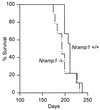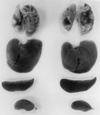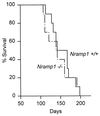Consequence of Nramp1 deletion to Mycobacterium tuberculosis infection in mice
- PMID: 10531233
- PMCID: PMC96959
- DOI: 10.1128/IAI.67.11.5811-5814.1999
Consequence of Nramp1 deletion to Mycobacterium tuberculosis infection in mice
Abstract
129sv mice functionally deleted of the antimicrobial resistance gene, Nramp1, were found to be as resistant as wild-type mice to infection with the virulent H37Rv strain of Mycobacterium tuberculosis, as determined by monitoring bacterial growth in major organs and recording host survival times. Death of infected mice of both types was associated with extensive infection-induced pathology in the lungs but not in other major organs. These findings are in keeping with the view that Nramp1 is of limited importance in resistance to tuberculosis in mice.
Figures





References
-
- Abel L, Sanchez F O, Oberti J. Susceptibility to leprosy is linked to the human NRAMP1 gene. J Infect Dis. 1998;77:133–145. - PubMed
-
- Bellamy R, Ruwende C, Corra T, McAdam K P W J, Whittle H C, Hill A V S. Variations in the NRAMP1 susceptibility gene and susceptibility to tuberculosis in West Africa. N Engl J Med. 1998;338:640–644. - PubMed
-
- Boom W H. The role of T cell subsets in Mycobacterium tuberculosis infection. Infect Agents Dis. 1996;5:73–81. - PubMed
-
- Buschman E, Vidal S, Skamene E. Nonspecific resistance to mycobacteria: the role of the Nramp1 gene. Behring Inst Mitt. 1997;99:51–57. - PubMed
Publication types
MeSH terms
Substances
Grants and funding
LinkOut - more resources
Full Text Sources
Medical
Molecular Biology Databases

